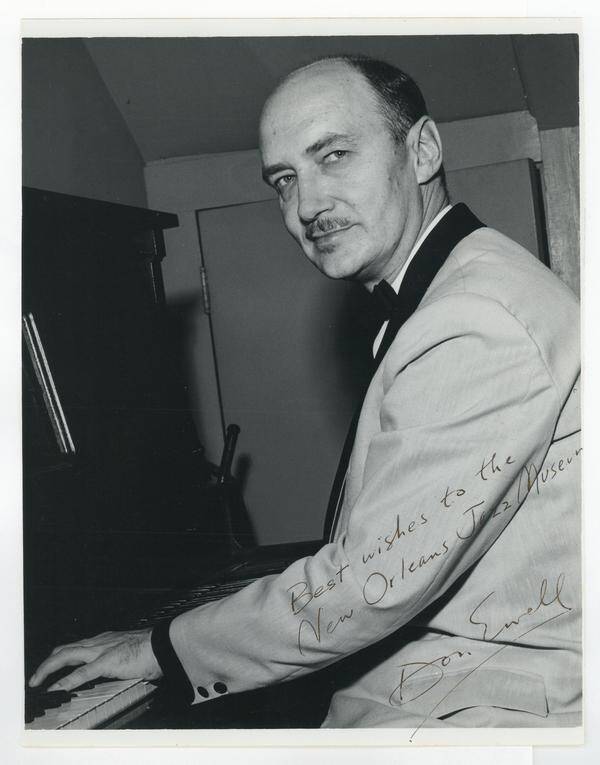
Hal Smith: In 1965 I obtained the Good Time Jazz LP Kid Ory’s Creole Jazz Band—1954. Besides Ory’s righteous tailgate trombone and the fantastic rhythm section, the elegant, stately Morton-inspired piano sound on “Maple Leaf Rag” and “Wolverine Blues” and the ebullient but unhurried striding on “I Found a New Baby” made me an instant fan of Don Ewell. Next, I picked up Music To Listen To Don Ewell By—also on the Good Time Jazz label. It contained a solo piano version of “I Can’t Believe That You’re In Love With Me” that is still my favorite recording of that particular song.
Subsequently, my admiration for Don Ewell’s superb piano playing increased with each recording I heard: The trio records with Bunk Johnson and Alphonse Steele; the solo LPs on Windin’ Ball; solos, trio and quartet sides on Good Time Jazz; LPs and Club Hangover broadcasts with Kid Ory; the 1957 “studio recital” in Berkeley and home recording in Chicago; the 1966 concert with Barbara Dane and the series of solos recorded by Hank O’Neal in 1969. For me, all of those performances are desert island-worthy. When asked to name my favorite pianists from the past, I never hesitate to include Don Ewell on the list with Jelly Roll Morton, Earl Hines, Joe Sullivan, Jess Stacy, James P. Johnson and Fats Waller — especially since I hear all those influences in his playing! I missed an opportunity to hear Don Ewell in person, just before he passed away. That is still one of my greatest regrets. However, I continue to enjoy hearing Don Ewell’s influence on so many contemporary pianists.
I believe that if Jelly Roll Morton had lived long enough to hear Don Ewell’s 1946 recordings, he no doubt would have considered Ewell to be “on the right track.” Other pianists who did hear Ewell had high praise for his playing: James P. Johnson considered Ewell to be a peer. Eubie Blake described Ewell’s playing as “Just like the old-time greats, only better.” Count Basie once said that “Don didn’t miss a note.” The majority of my musical associates would agree with these statements, so I have asked several of them to share their thoughts regarding Don Ewell. We begin with someone who was Don Ewell’s friend for over 30 years…
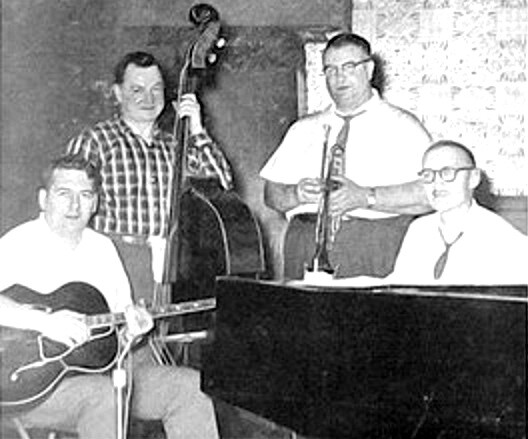
Marty Grosz (Musician—Philadelphia, Pennsylvania): I first encountered Don Ewell at the Hyde Park (Chicago) YMCA (So. 52nd St.?) in Chicago, in 1948. My pal, Hugh McKay, and I had hitch-hiked from NYC to see the world. Our aim was to reach the West Coast and then to get to L.A. and Hollywood, and to be discovered at Schwab’s Drugstore, where a well-known star (was it LANA TURNER? I’ve forgotten) was NAILED by a Hollywood Huckster in search of a pretty face and a nice set of gams.
Arriving in Chicago we looked up Bob Lovett, a Doddsian clarinetist, who was tending bar at the University Tap, next to the U. of Chi. Lovett and Bill Price, a trumpeter, ad others had been driving out to a V.A. hospital where Don Ewell had been undergoing treatment for a breakdown. Now he was released and living at the 52nd St. YMCA. It was thought that affording Don some opportunities to play jazz would improve his condition. McKay and I joined Bill Price, Bob Lovett, and others to jam at the Y.
Don Ewell was light years ahead of us. I was struggling with a four-string guitar, trying to keep up with Don, as we played Jelly Roll Morton’s “Wolverine Blues” (or something like it).
Don’s big talent helped him to absorb tunes and styles rapidly. His younger acolytes, myself included of course, tried to keep up with Don, who was a fountain of information, and a purveyor of several different styles. His renditions of tunes in the manner of Waller, Morton, Teddy Wilson, and others seemed to me to be spot on. It was my good fortune to be asked to play on several record dates in Chicago. I was not in Don’s league, nor near it. My participation occurred because the sponsors of the dates liked me.
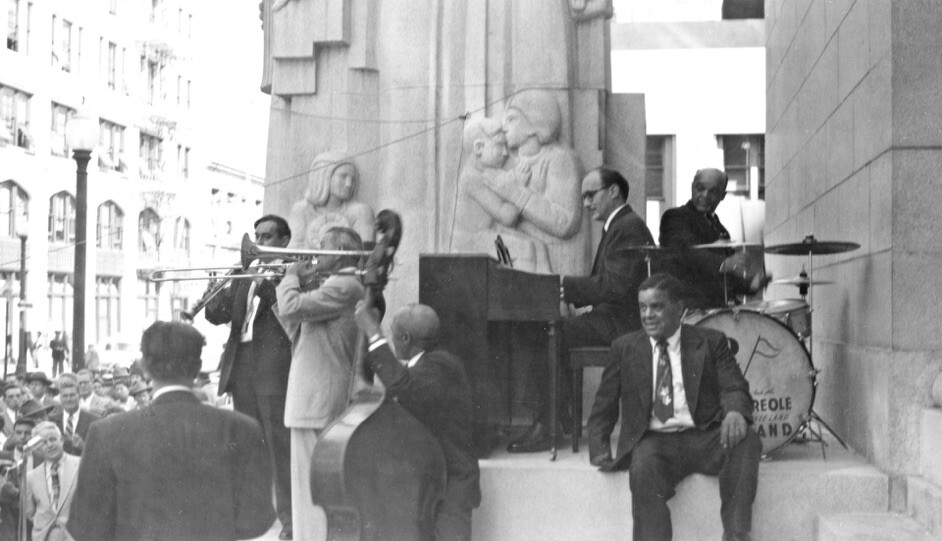
One of Don’s particular favorites was Bunk Johnson. At the close of World War II, some well-intentioned MOLDY FIGS thought it would be illuminating to bring trumpeter “BUNK” Johnson to N.Y.C. and present him to the SLICK, apathetic New York sophisticates, and wouldn’t it be great if they could present him with a genuine New Orleans ensemble. And so they did, much to the derision of those “SLICK,” “OVER-TRAINED,” BIG TOWN (NYC) Be-Boppers and QUASI-sophisticated BIG BAND players.
The RE-DISCOVERED masters of “authentic” New Orleans Jazz of the 1890s into 1920s, would demonstrate what “REAL” “soulful,” JAZZ MUSIC was all about. And so it flourished for a couple of years, getting a lot of press and recording.
The only real pros in the Bunk Johnson band were the great New Orleans drummer, Baby Dodds, and Bunk—a thoroughly-trained trumpeter, who had spent years reading difficult scores as a CIRCUS MUSICIAN, appreciated by the likes of Harry James.
Don Ewell had a particular fondness for Bunk’s style. He made several recordings with his idol.
In the 1950s after a couple of years in the Army I returned to Chicago for a visit that lasted 20 years. Much of that time was spent playing in a trio at a Key Club in Chicago named the “Gaslight Club.” I had to buy a banjo and entertain the jolly drunks who frequented the place. When I received an offer to travel to New York and make several LP records, my first call was to Don Ewell, who happened to be in that city with Jack Teagarden’s band. I wrote a bunch of arrangements but at the last minute the producer vetoed my tune list and had us play all public domain material, at that time music from before 1903 (or thereabouts). None of us were happy with the old Gay Nineties repertoire—NOT because the tunes were all ghastly, but because they were so well-known and common, and there wasn’t enough time to cook up ideas to make them sound a bit fresher.
Later, after the Gaslight Club, I was on the road. One evening I was strolling along Yonge St. in Toronto when I heard sounds that stopped me in my tracks: Benny Goodman and Teddy Wilson were playing “It’s Been So Long” in a club with its door open: a perfect rendition. I stepped in and saw clarinetist Henry Cuesta and pianist Don Ewell. If they had recorded their performance it would have have been difficult to distinguish it from the work of their models.
While they were both working with Jack Teagarden at Chicago’s London House, I got word that on a particular Saturday night an important agent was coming to hear the band, especially to hear Don Ewell—for whom a concert tour might be in the offing.
Business was good, the joint was packed, my wife and I, and many fans were there to cheer Don onward to impress the agent. And so it came to pass that at one set’s last number (a big closer) Jack called “The Saints Go Marching In,” and after the horns had soloed he turned the tune over to Don.
Don gave a mesmerizing, riveting performance (I could pile on the adjectives, but you get the idea). Each chorus was more exciting than its predecessor: Don emulated the styles of Wilson, The Lion, Hines, Jelly Roll, etc. etc., ending with a thundering brace of Waller choruses that brought a wide smile to Jack Teagarden’s satchel cheeks. (Jack and Fats were old pals). The audience hooted and whistled and beat their palms together. Alas, the agent never showed up.
That event might give us a clue as to why Don Ewell never got the renown he deserved. Popular music was, in those years, becoming the business of the Elvis Presleys and the Beatles.
Children weren’t being given piano lessons, nor were they taught other instruments, nor does it appear that they will be in the future (e.g. In a city like Philadelphia, there is not one bar or restaurant where someone is playing piano).
“SIC TRANSIT GLORIA MUNDI.”
Steve Pistorius (Pianist—New Orleans, Louisiana): Don Ewell was equally brilliant as a soloist and band pianist. He always knew exactly how to play in any setting. He knew what to play and what not to play. No early jazz pianist has ever combined East Coast Stride (Johnson, Waller) and New Orleans (Morton) like Ewell did. Butch Thompson once remarked to me that part of Ewell’s uniqueness was the way he physically struck the keys. I agree. He achieved what most players only dream of, especially concerning his interpretation of Morton—he never copied or imitated. He seems to have absorbed the essence of the style and when he sat down to play Morton, he BECAME Morton without ever imitating him. Listening to any Don Ewell recording is like a master class in early jazz piano. He has been a profoundly positive influence on my playing.
Lucas Ferrari (Pianist—Argentina): We all heard him playing some wonderful classic jazz piano, from Morton to Harlem stride. But he is not just a stride player or a Jelly Roll style player. He is both, and he can play both things at the same time, combining the two styles in a beautiful and unique way. That is how I believe Morton would have played at some point if he had been more permeable to other musical influences and finally absorbed some of the Harlem stride idiom. (Luckily, he didn’t!)
 Ewell is also one of my favorite blues piano players. I’ve learned some of his blues licks to use in different contexts, from solo piano to electric blues band gigs. Much of his music is available on compact disc and the internet, but there are still some of his records that were only released many decades ago—such as the one he recorded in 1952 playing King Oliver’s music and the piano duets with Bob Greene from 1969. If you find a copy of any of these, buy it. You won’t be disappointed! Although somewhat forgotten in the eyes (and ears) of most of the jazz world, Don Ewell is undoubtedly one of the finest classic jazz pianists of his generation. Even when he’s not playing strictly Morton style, his music is “sweet, soft, and plenty rhythm.”
Ewell is also one of my favorite blues piano players. I’ve learned some of his blues licks to use in different contexts, from solo piano to electric blues band gigs. Much of his music is available on compact disc and the internet, but there are still some of his records that were only released many decades ago—such as the one he recorded in 1952 playing King Oliver’s music and the piano duets with Bob Greene from 1969. If you find a copy of any of these, buy it. You won’t be disappointed! Although somewhat forgotten in the eyes (and ears) of most of the jazz world, Don Ewell is undoubtedly one of the finest classic jazz pianists of his generation. Even when he’s not playing strictly Morton style, his music is “sweet, soft, and plenty rhythm.”
Mike Lipskin (Pianist—Kingman, Arizona; pupil of Willie “The Lion” Smith): What’s not to write about this individual, special, inspiring hot jazz pianist?
Had the lucky and unforgettable pleasure of hearing Don Ewell, solo and duets, with my mentor, Willie the Lion Smith, at the Village Gate, circa 1965 (NYC Bleeker Street). He was unassuming, and dressed conservatively, like an insurance salesman, a non sequitur to his multifaceted and swinging piano.
He mastered the art of stride jazz piano nuance, more relaxed than many, with fine passing chords. His varied stride left hand supported right hand references to Fats Waller, James P. Johnson, then segueing seamlessly to the non-stride mannerisms of Joe Sullivan, Teddy Wilson, or Jess Stacy.
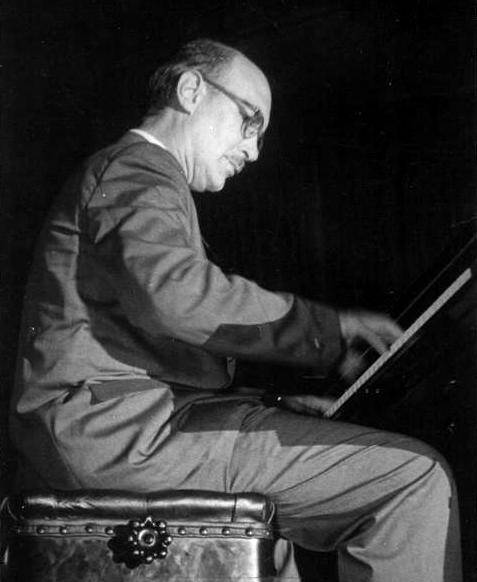
And he could perform expertly in the Jelly Roll Morton idiom, showing that his expert ear and hands allowed him to bring Morton’s genius alive.
On top of that, he displayed spontaneous improvisation, and had an underlying, CLEAN technique that NEVER sounded ponderous. If that was not enough, his accompaniments were interestingly inventive, but uncluttered under a horn or reed soloist; only getting busy during the right phrases.
His performance had innate TASTE.
Don’s left hand/arm was injured by an auto, if memory serves, in a Florida parking lot. The case went to trial. Dick Wellstood, another excellent jazz pianist—also an attorney—flew down from NYC to appear as an expert witness on the damage issue. A piano was moved into the courtroom, where Dick demonstrated stride jazz, specifically to show the jury and judge the indispensability of the left hand.
Don Ewell deserved much more recognition during his long career. So glad that Hal Smith has assembled this long overdue tribute.
I’m listening again to his fine solos, and will be trying to steal some of his stuff.
Hank O’Neal (Writer, photographer, Chiaroscuro Records producer and author of the forthcoming book Moments Worth Years – Jazz Lives and Memories): Don Ewell was perhaps the most sophisticated and sensitive of the pianists who emerged in the 1940s who played in older, old-fashioned styles. I don’t remember who introduced me to him, but whoever it was has my eternal gratitude. It was in 1967, just after I’d moved to New York City from Washington D. C. I’d rented a modest apartment on Charles Street in Greenwich Village and when the fall rolled around Don was sleeping on my couch by day and by nights playing duets with Willie The Lion Smith at the Village Gate. In between the Village Gate and 15 Charles Street, on most nights he’d hang for hours at a chess club on Thompson Street before waking up my doorman at 4:00 AM to get into the building. In later years I always wondered who was better, Dick Wellstood or Don Ewell. At chess, not piano. (Quote used with permission.)
Loren Schoenberg (Senior Scholar, The National Jazz Museum In Harlem): Don Ewell was a great jazz musician. Some people get hung up on style, but that’s just the outer manifestations of musicianship. It made no difference what the idiom of the music that Don played, because it all had that spark, that sound of surprise that is essential to the best jazz in jazz.
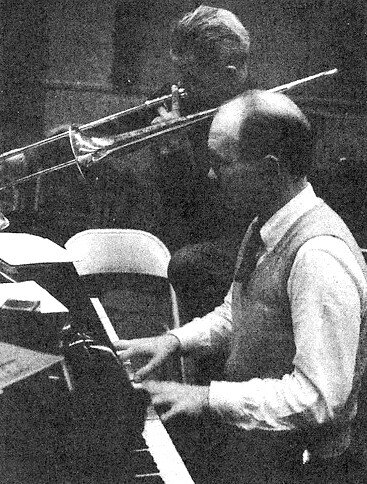
My respect for his art was amplified when I heard about his precociousness as a young man from one of my mentors who knew him back when they were young in Baltimore—Dick Katz. Dick was also enamored of the piano styles that preceded Bud Powell, and he never tired of telling me how Don, even back in the early 1940’s, was always in the moment, no matter what the musical setting was.
The first times I really dug into his music was the Chiaroscuro album with Buddy Tate on one side and Herb Hall on the other. From then on it was just a matter of digging deeper to find out more about this remarkable musician. If he had a peer, it was probably Dick Wellstood, and although their approaches were quite different, they were really the keepers of the flame.
Ida Melrose Shoufler (Daughter of pianist “Kansas City Frank” Melrose): I am listening to one of the CDs you sent to me by Don Ewell. I listen to them often. His magic at the piano is something I never get tired of listening to. Whether it’s the blues, or something like “I’m Gonna Stomp Mr. Henry Lee,” I listen and I wish I could have met this awesome piano player. Thanks to you for introducing me to his music. I only had to listen to this CD one time and I was hooked! I think, along with hundreds of others, that Don Ewell is one of the “greats” and his music is everlasting, What a blessing!
Michael Steinman (JAZZ LIVES Blog): I first heard Don as a member of the Jack Teagarden sextet, doing his own version of Fats, but it wasn’t until I picked up the Jazz Portrait of the Artist—recorded by Hank O’Neal—that I truly began to value him. Stride piano often emphasizes volume and speed, but Don had the gracious lightness of a great dancer. Although he could “become” Jelly Roll, he always had a leisurely swing phrasing.
Stephanie Trick (Pianist—U.S./Italy): Don Ewell had such mastery of the stride piano style. When I listen to Ewell, I hear the influences of the original stride masters like James P. Johnson and Fats Waller transformed into something fresh and totally his own. He had one of the most natural, swinging, tasteful approaches to solo piano. I love his touch, too—that great sound he could create— which was punchy but never harsh, and so full and rich.
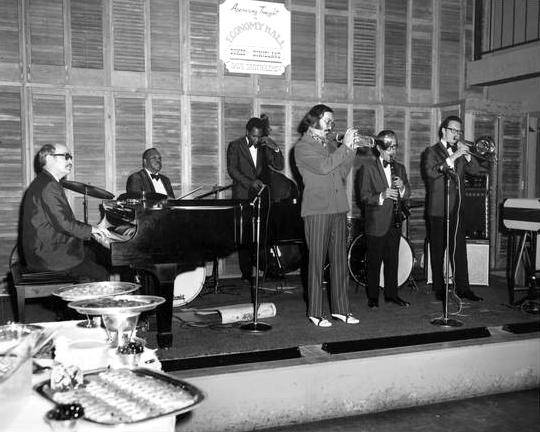
Paul Asaro (Pianist—Chicago, Illinois): I first discovered Don Ewell when I was in college and just getting into stride piano. I was out and about in Chicago searching for any record LPs by any and all stride players that I could find. I found a Ewell LP called Chicago ’57 at Jazz Record Mart. It came out on the Stomp Off label in the mid ’80s. At any rate it quickly became one of my most prized albums in the genre. I was already listening to Dick Wellstood and Ralph Sutton and Don’s playing immediately placed him in that top category of the so-called “second generation” stride players. The liner notes describe the session as a private home recording for a jazz fan and Ewell is loose and relaxed after “interminable games of chess, combined with liquid refreshment.” I was really impressed by his ability to drift from the stride piano style to the Jelly Roll Morton New Orleans style with such ease. He could play both styles authentically while still maintaining his own recognizable personality at the keyboard. Chicago ’57 still remains my favorite Don Ewell record.
Kris Tokarski (Pianist—New Orleans, Louisiana): Don Ewell is part of what I would call the 2nd generation of traditional jazz pianists. By the time Ewell was an aspiring pianist, a tradition had been established and therefore the process of learning and creating a voice within the style is fundamentally different than the original generation of jazzmen. For all of us “born too late,” Ewell is the gold standard and an inspiration on how to absorb, develop upon, and create your own voice within this great tradition.
Andrew Oliver (Pianist—Portland, Oregon): What particularly strikes me about Don Ewell’s playing was his ability to internalize and fuse the styles of the early pioneers, particularly Morton, Johnson, and Waller, into a unique approach that honors all of their styles while creating something new within the context of the stride piano tradition. Because of his age, he was one of the first pianists to have the opportunity to synthesize ’20s and ’30s styles into something so unique and captivating. Also, as a Morton enthusiast, I believe that no other pianist since Jelly’s death has understood and performed the true Morton style better than Don Ewell (specifically on his album of King Oliver tunes)!
Hugh Crozier (Pianist—U.K.): I had the pleasure of meeting Don Ewell once in a club in London when he played “The Pearls” for me. I was delighted that to my ear he pronounced it “Poils.”
That would have been about 1969-70. I was in Steve Lane’s band at the time. I very much enjoy Don’s hot but elegant playing and I was amazed to discover from William Russell’s Oh Mr Jelly that his transcription of Jelly’s “Fingerbreaker” was transcribed from memory and that he did not use a piano in the process. That shows a thoroughly excellent musical mind and someone who understood Morton through and through. To my mind it bears comparison with Mozart transcribing Allegri’s Miserere after one hearing.
In the 1946 trio sessions with Bunk, for example, there is no doubting Morton’s influence, especially in his accompaniment style, but clearly other influences are there too, especially Fats Waller. But Don Ewell was also clearly his own man, with hot playing interspersed with delightfully florid embellishments. He was a fluid, thoughtful and technically accomplished player.
One small coincidence—I live in Cheam, Surrey. The next town to the east is Sutton, and to the west is Ewell. Moreover, Neville Dickie still lives one town further east from Sutton! Everywhere I look are echoes of great stride players.”
Louis Mazetier (Pianist—France): Don Ewell is one of the most underrated musicians of the history of Jazz (which is full of sad other examples) despite the fact that he was, for a while, the right man at the right place during the revival of trad jazz after WWII. We can hear him in the ’40s with Bunk Johnson and in the ’50s with Kid Ory and Jack Teagarden. However, my opinion is that he deserved a better place in the pantheon of the great jazz pianists. Nowadays his name is hardly mentioned in books about jazz pianists, probably because he didn’t have a crucial influential position; he was not James P. Johnson, or Earl Hines or Teddy Wilson, Art Tatum, Bud Powell or Bill Evans. But in the same books, other gifted followers get a chapter, and Don doesn’t.
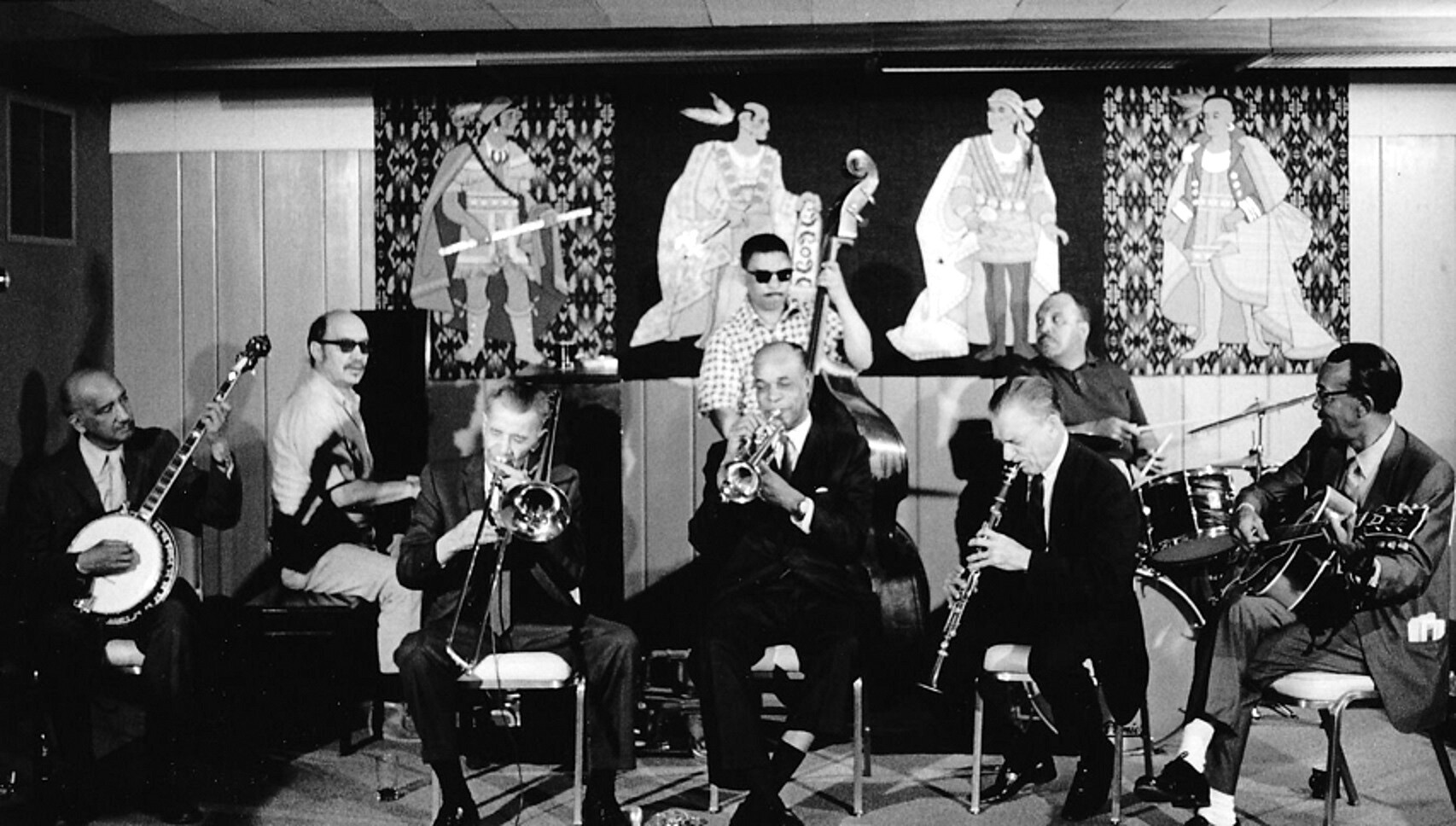
At an early age, when I was trying my hands at stride and traditional jazz piano, I was under my first influence, Fats Waller. I soon discovered the other striders and Don was quickly one of my great favorites and stayed a lifelong influence, probably because he was a synthesis of everything I was fond of: stride of course, but also Jelly Roll, the swing style of the Hines-Wilson school and the blues. Even today, as I digested many other things in jazz, Don stays as a keeper of the flame. He’s always been very honest with the music he chose to play; very careful with the melody and the chords of a tune. He makes them sound as if you never realized this song was so nice before. He never shows off, despite the fact that he had the best technique a piano player can dream of (my friend François Rilhac said that Don never played a wrong or a blurred note). In the bands where he played, he never steals the show, because he doesn’t need to. He’s playing exactly the right thing at the right time. Same with the singers: helpful and opportune. Listen to what he does behind Mama Yancey. One can regret he didn’t have more opportunities to accompany better singers!
One can argue that he was not a great original like the Lion, Monk, or Garner. OK…but music can be beautiful however, and exciting: Benny Carter, Benny Goodman, Cootie Williams, Bobby Hackett, Hank Jones and many others weren’t that much originals either, but they played so well that nobody cared. They had their style and that was it. Like Don Ewell, whose playing is a perfectly balanced mixture of stride, Morton, and swing piano; tasty, elegant…but also strong and swinging hard. Moreover, Ewell was the initiator of a long dynasty of stride-influenced jazz pianists to come, including great talents as Ralph Sutton, Dick Wellstood, and Dick Hyman who all paid their tribute to Don. This story is still going on, thanks to Don Ewell.
I am listening to his records very regularly and always find new little things in his great playing, as a soloist or as a band pianist. He always lifts up the band he’s playing with and is not uncomfortable with bass players (which is often the case for striders). Fortunately, we have many recordings, among them a great amount of private sessions where he was more at ease than in a studio. It is difficult to make a selection of my Ewell favorite records—they are too many and Don always plays extremely well. Nevertheless, I have to mention his duets with The Lion (Steeplechase) suffering an impaired balance with Smith a bit too strong. Then, the Oliver compositions (Windin’ Ball), the trio/quartet sides with Darnell Howard, (Good Time Jazz), the Denver solo concert where he is at his top (Storyville), the KPFA unissued radio recordings (1957) and the Sterling Nelson unissued tapes of 1961. I never saw Ewell and I missed the occasion in London where he was playing at the 100 Club in 1980. I still keep regretting it.
Neville Dickie (Pianist—U.K.): I can tell you about a wonderful experience I had with Don! He came to England (I don’t remember the date unfortunately) to raise money for his daughter—who I believe had leukemia. He played at the Pizza On The Park for one night (I remember it being a Monday)—the place was packed with fans and musicians. I had the pleasure of playing a duet with him—“Keepin’ Out Of Mischief Now”—and of course it was a dream come true for me. Unfortunately, Don had arthritis in his hands and wasn’t at his best.
When Don was on form, there was not another Stride pianist to match him. He brought a bluesy feeling into his playing—which was rare among Stride players. He could also swing mightily.
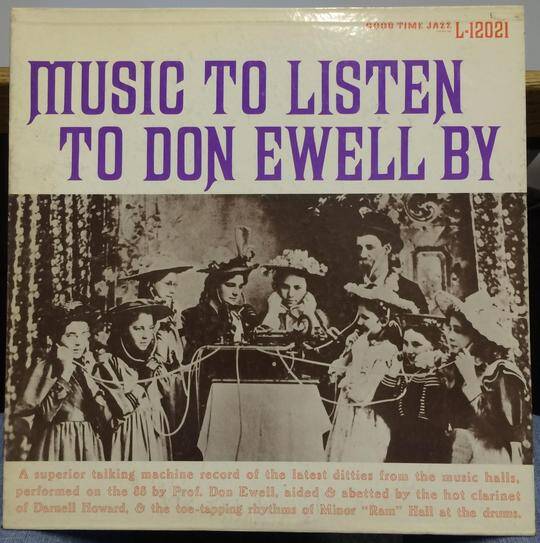 Sonny McGown (Co-author of “The Jump Records Story”; Former IAJRC Trustee): Circa 1958 I first learned of Don Ewell on a nightly AM radio broadcast by Felix Grant on station WMAL in Washington DC. Felix featured new LPs in both the classic and modern jazz idioms and he was ecstatic about a recent release on the Good Time Jazz label titled Music to Listen to Don Ewell By. I was absolutely floored by the ebullient sound, harmony and camaraderie of the trio of pianist Ewell, clarinetist Darnell Howard and Minor Hall at the drums. Thanks to my father, I had grown intimately familiar and enthralled by the great Benny Goodman Trio but there was something so different about Don’s trio. I’ve come to realize that despite the brilliance of the veterans Howard and Hall, Don Ewell was the catalyst and centerpiece responsible for that magical sound. Don’s solos were sparkling amalgams of Fats, James P., and Mr. Jelly but with his own unique flair. Equally skillful were his solid backing of clarinetist Howard that was clearly inspiring and perfectly rhythmic and always meshed neatly with drummer Hall. Hence, for over 60 years now, I have collected every recording by Don Ewell that I could find. To this day my first Ewell LP acquisition remains a desert island disc without question.
Sonny McGown (Co-author of “The Jump Records Story”; Former IAJRC Trustee): Circa 1958 I first learned of Don Ewell on a nightly AM radio broadcast by Felix Grant on station WMAL in Washington DC. Felix featured new LPs in both the classic and modern jazz idioms and he was ecstatic about a recent release on the Good Time Jazz label titled Music to Listen to Don Ewell By. I was absolutely floored by the ebullient sound, harmony and camaraderie of the trio of pianist Ewell, clarinetist Darnell Howard and Minor Hall at the drums. Thanks to my father, I had grown intimately familiar and enthralled by the great Benny Goodman Trio but there was something so different about Don’s trio. I’ve come to realize that despite the brilliance of the veterans Howard and Hall, Don Ewell was the catalyst and centerpiece responsible for that magical sound. Don’s solos were sparkling amalgams of Fats, James P., and Mr. Jelly but with his own unique flair. Equally skillful were his solid backing of clarinetist Howard that was clearly inspiring and perfectly rhythmic and always meshed neatly with drummer Hall. Hence, for over 60 years now, I have collected every recording by Don Ewell that I could find. To this day my first Ewell LP acquisition remains a desert island disc without question.
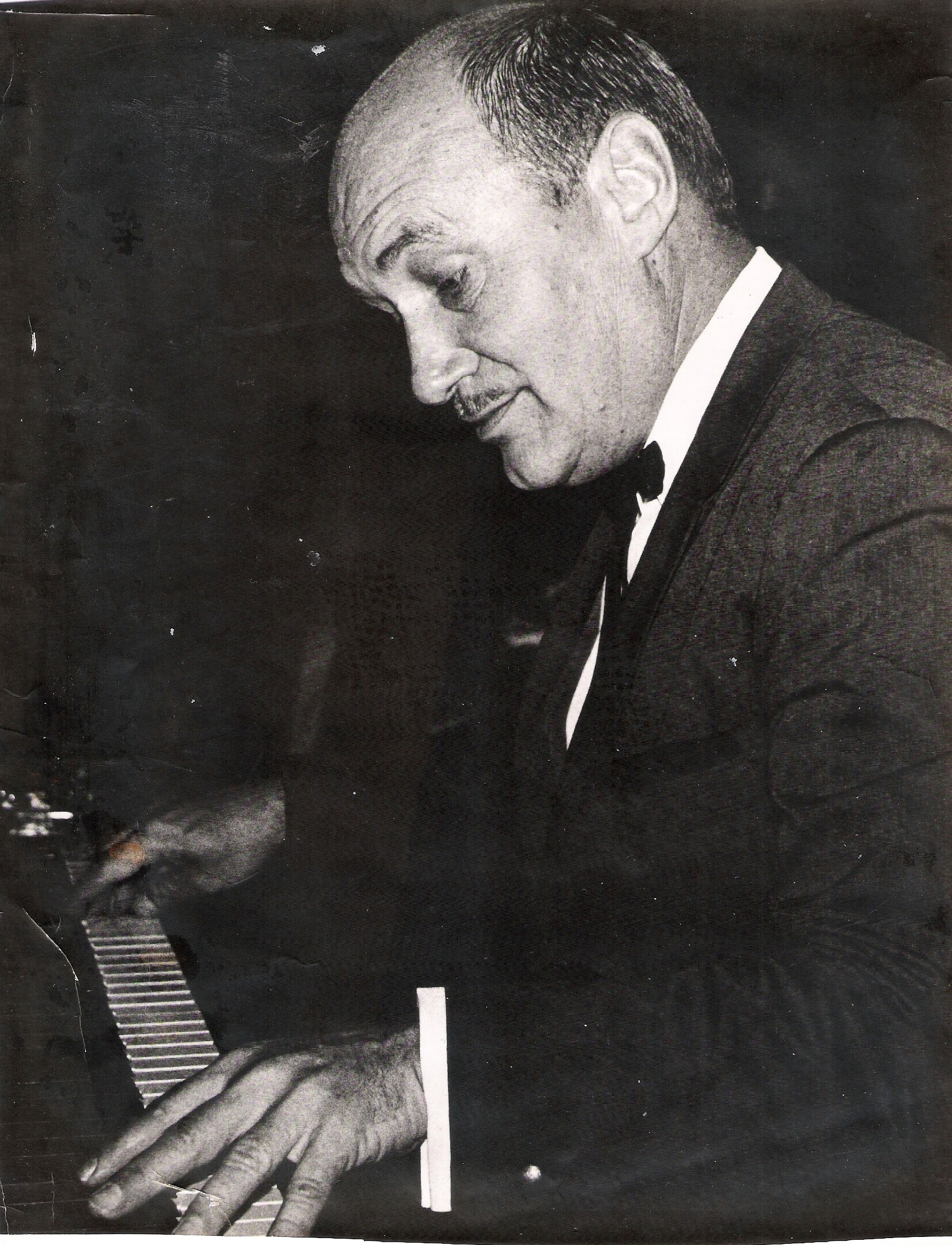
Ted des Plantes (Pianist—West Chester, Ohio): As a pianist, I always considered Don Ewell to be a quiet virtuoso. He never tried to impress the listener with tricky, fast fingerings, blazing runs or “modern” harmonies far afield from the compositions he was playing. In his prime his was a true two handed style, with a strong left hand dominated by strong but not overbearing stride or a likewise balanced stomp reminding somewhat of Jelly Roll Morton. By choice, the majority of his solo repertoire was dominated by 1920s classic jazz material (many “King” Oliver and Morton tunes) plus Fats Waller showpieces and early Swing Era standards. His own compositions (which can be heard scattered throughout his Good Time Jazz albums and recordings as a sideman with the Jack Teagarden Band) revealed his fealty to early jazz composers. He was a great rhythm section player who usually avoided really fast tempos in order for his cleanly played, sophisticated, yet earthy harmonies to prevail along with his propulsive rhythm.
Ewell was always highly regarded by musicians, yet he never achieved great popular fame and the financial largesse that goes with it. All recordings under his name were on small, independent labels with limited distribution. Only the aforementioned Teagarden sides on Capitol and Verve saw his music presented to a larger audience. Aside from Teagarden he was part of trombonist Kid Ory’s Creole Jazz Band in San Francisco on several middle-1950s Good Time Jazz releases (most still available on CD along with radio remotes on other labels). Long periods of his career were spent in anonymity, playing out of tune pianos alone or with local bands in St. Louis, New Orleans and Miami.
During his long sojourn in New Orleans, Ewell was sought out by a young pianist named John Royen who studied with him. Today, listening to Royen is almost like listening to Ewell. John Royen adopted Don Ewell’s style as his own, which is great. Other accomplished pianists who were influenced by Ewell but have retained their own style are Richard “Butch” Thompson and the English player Ray Smith—who also studied with him—as well as Kris Tokarski.
Don Ewell’s best recordings were with trumpeter Bunk Johnson’s trio in the late 1940s and the previously mentioned Good Time Jazz and Jack Teagarden recordings. A 1950s LP of tunes associated with King Oliver is great but is nearly impossible to get.
Late in his career while riding his bicycle Ewell was struck by a careless motorist and sustained severe injuries to his left arm and shoulder. He made records after that but, although good, they just weren’t the same.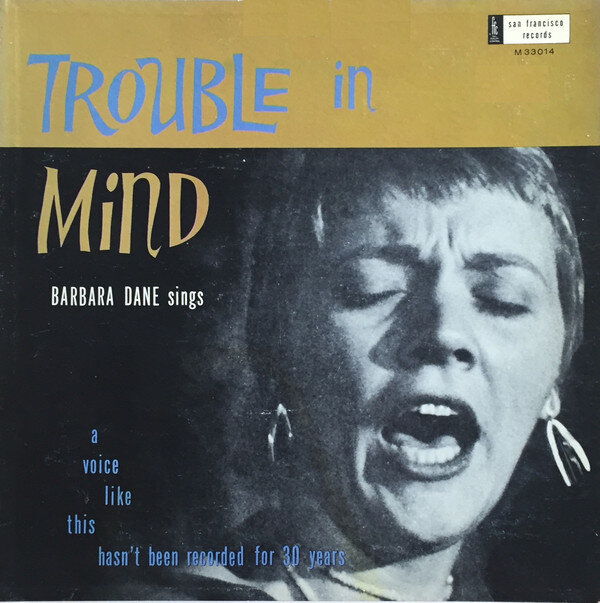
Don Ewell can be seen in a film of Jack Teagarden’s band touring USO sites in Korea and a TV show filmed in Toronto with Willie “The Lion” Smith. On the latter “The Lion” dominates but Ewell has some fine moments. He did a studio recording club date while there with Smith that’s pretty good but a recently released club date recording of the duo is poor due to very erratic playing by “The Lion.”
I’ve always had the highest respect and admiration of Don Ewell’s playing. Bits and pieces of his ideas turn up in my own pianistic output. Secondly, he had a perfect sense of time. Right on the beat, he always sounded relaxed, never mechanical. He could alter his style depending on the circumstances. Listening to the Kid Ory airchecks, he would occasionally quote from a classic ragtime selection (James Scott’s “Grace and Beauty” for instance, on a stompy “Original Dixieland One Step”) or approach Teddy Wilson’s light fleetness (“Chinatown”).
Harriet Choice (Former jazz critic—Chicago Tribune; a founder of the Jazz Institute of Chicago): Don Ewell is an overlooked glorious piano player from stride to classic ballads. He could play anything and everyone should take a listen.
Steve Pikal (Bassist—Eden Prairie, MN): Don’s great rhythmic approach swings, supports, and simply always elevates a band. He’s a true treasure every time I listen to him.
Yoichi Kimura (Drummer, the New Orleans Rascals of Osaka): Before Don Ewell came to play at the New Suntory 5, Junichi Kawai, Satoshi Adachi (Rascals piano player at that time), and I took him to a bar named “Sera Bar” in the very best hotel in Osaka. (The name “Sera” is a very famous modern jazz pianist in Tokyo, who comes to Osaka to have solo gigs once a month, at New Suntory 5 on Friday and Sera Bar on Saturday). When we got there, we asked the manager to open up the piano so that this gentleman from the USA can play and entertain us and other customers so good—because he is very famous all over the world and is the very best trad jazz pianist (much more famous than Mr. Sera, who was not there because it was a weekday). Of course Don Ewell played solos and all customers enjoyed and praised Don’s playing, although nobody there but us knew Don Ewell.
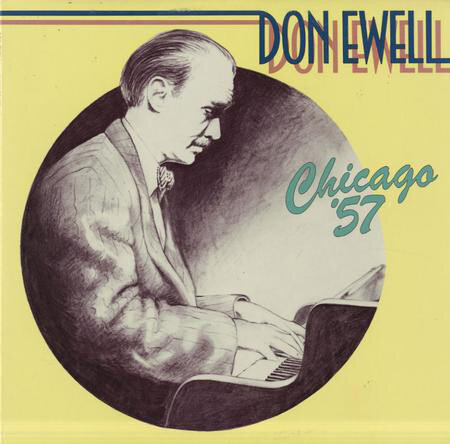 At the first moment Don Ewell arrived in the New Suntory 5, and sat on the piano (YAMAHA) he yelled “Are you gonna let me play the Japanese Motorcycle?” The result you can hear the LP titled The New Orleans Rascals at New Suntory 5 with Don Ewell.
At the first moment Don Ewell arrived in the New Suntory 5, and sat on the piano (YAMAHA) he yelled “Are you gonna let me play the Japanese Motorcycle?” The result you can hear the LP titled The New Orleans Rascals at New Suntory 5 with Don Ewell.
Later, Mrs. Mori—the owner of the New Suntory 5 at the time—finally fired Mr. Sera because she found out Mr. Sera didn’t know much about who Don Ewell was. (Also he was sometimes too much drunk to keep playing the piano).
Tom Roberts (Pianist—Pittsburgh, PA): I have always been fascinated and delighted by the work of impersonators such as Rich Little and Frank Gorshin. It was a dream of mine to try and emulate the pliable palates of these guys; to be able to manipulate my voice in order to emulate the way someone else spoke. Now this brings us to the question of why we sound differently from other people? Of course this is based entirely upon what we heard as children as our own palates were developing and how we manipulated our mouths to make the sounds we heard our parents and neighbors making. So to use the limits of the written word to express the sound of how different regional dialects would sound using the phrase, “I’ll meet you down by the water” The new Orleanian would say in a languid drawl: “Ahll meet choo doawn bahey the wahhtah.” In Baltimore they would say: “I’ll meet choo down by the wooter.” And the Pittsburgh yinzer would say it: “Ah meet cha daahhhhn by da war.” I bring this up to express my admiration of what Don Ewell did, albeit on the piano keyboard.
Back in the days before someone learned how to play jazz at a university by reading things from a book, the language of this music was transferred in a much similar way to which we develop our own speech patterns. When we have fallen in love with this sound we generally listen to and emulate the sound of our heroes. Some of us take on the creole drawl of Jelly Roll, others choose the path of Harlem and fill our musical vocabularies with the sounds of Fats and James P., and so many other possibilities for learning through listening. Now this is all a fabulous and worthwhile tool to gain especially if you are involved in repertory ensembles like Vince Giordano and the Nighthawks and the Louisiana Repertory Jazz Ensemble. When playing with Vince (like I did) if he pulls up a Jean Goldkette transcription—you better not play like Herbie Hancock! Same with everything else in that book!
As I was preparing to share my thoughts on Don Ewell, I was driving to his hometown of Baltimore to perform with an ensemble from his alma mater (The Peabody Conservatory Ragtime Ensemble) and listening to the mature art of Don Ewell on his later recordings and delighting by the way he combined all of the different regional accents to create a sound that is wholly HIS OWN. And a pianist has two hands with which to use these various dialects!! As I listened to the album I heard flashes of Jelly Roll Morton, Willie “The Lion” Smith, Fats Waller, James P. Johnson, Erroll Garner (!), Jimmy Yancey, Joe Sullivan, Luckey Roberts, Eubie Blake, Duke Ellington and many others, all combined in a unique way that sounds unmistakably like Don Ewell. Ewell would also mix the regional dialects between the two hands like using a Willie The Lion left hand while playing a Jelly Roll inspired right hand figure. A cunning linguist who has compiled a huge two-handed vocabulary with which to express any musical thought that crosses his fertile mind! Listen to Don Ewell! Your happiness will increase!
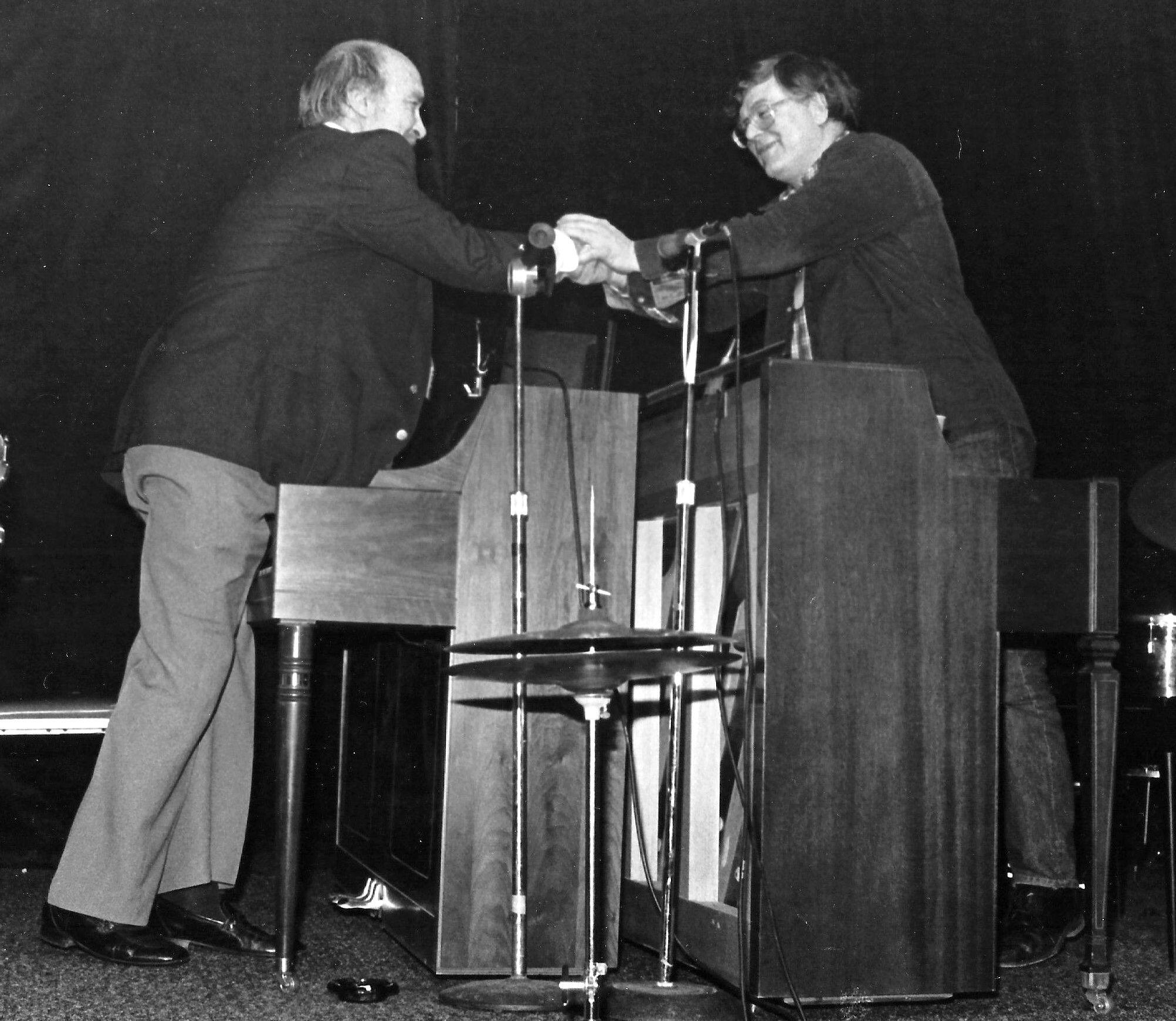
Mark Borowsky (Formerly World’s Second Leading Authority on James P. Johnson): You know that James P. put both Don and Johnny Guarnieri into the same class with himself and Fats. This was according to their mutual friend, David Gellman. I would agree, as I know you do too, on the perfect stride solo: Don’s “I Can’t Believe That You’re In Love With Me.” I used Don to illustrate the prototypic/quintessential modern stride player on my Jazz Rhythm programs on James P., with Dave Radlauer. Can’t say enough good things about his playing: swing, voicings, and inventiveness definitely put him in the top tier.
Jeff Barnhart (Pianist—Mystic, CT): I was always impressed with Ewell’s ability to channel Jelly Roll Morton AND the stride guys in both his playing and composing while always keeping his own singular voice at the forefront. He was not a copyist; he was a synthesizer and amalgamator but above all a creator of polished, urbane, sometimes hot and ALWAYS swinging piano. And he rarely rose above a mezzo-forte volume. His duo album with the “Lion,” in which either pianist is heard in his own channel, reveals the light touch with which Ewell played, while never taking back seat to the more aggressive, nearly bombastic playing of his elder.
Chris Tyle (Musician—France): I first became aware of pianist Don Ewell from his work on trombonist Turk Murphy’s Columbia LP, New Orleans Shuffle. I was impressed with his Mortonesque approach and his swinging playing. At that time, in the early 1970s, finding more recordings with Ewell proved to be challenging, but on a chance visit to “Long Hair Music” in Portland, I came across one of Ewell’s Good Time Jazz albums, Man Here Plays Fine Piano. The minute the needle dropped I was enchanted, not only by Ewell’s marvelous ability, but also by clarinetist Darnell Howard and drummer Minor “Ram” Hall. This album, and the other two the group did for Good Time Jazz, remain favorites.
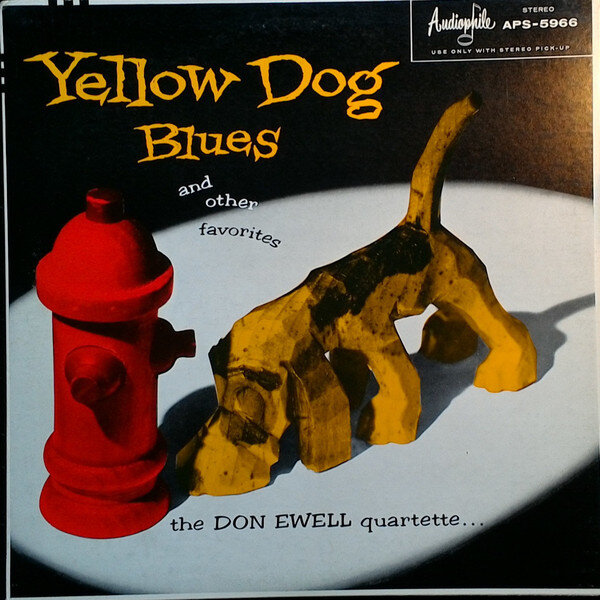 Over the years I expanded my collection of records with Don, including such gems as the Windin’ Ball LPs King Oliver Creole Jazz Band Tunes and Don Ewell – Pianist. But others stand out, like the Audiophile LP Yellow Dog Blues with the marvelous and underrated trumpeter Nappy Trottier, and the session with vocalist Barbara Dane Trouble in Mind, which included clarinetist Howard, trumpeter P.T Stanton, trombonist Bob Mielke, and bassist Pops Foster.
Over the years I expanded my collection of records with Don, including such gems as the Windin’ Ball LPs King Oliver Creole Jazz Band Tunes and Don Ewell – Pianist. But others stand out, like the Audiophile LP Yellow Dog Blues with the marvelous and underrated trumpeter Nappy Trottier, and the session with vocalist Barbara Dane Trouble in Mind, which included clarinetist Howard, trumpeter P.T Stanton, trombonist Bob Mielke, and bassist Pops Foster.
Unfortunately I never had a chance to see and hear Don in person, but his work on record continues to impress me. His fabulous concept of rhythm, knowledge of the earlier masters of jazz piano, and keen awareness of how to play in ensemble never fail to bring a smile to my face.
John Royen (Pianist—Folsom, Louisiana. Studied with Don Ewell): When I first heard Don’s playing, it was a revelation. Up until that point most of what I heard were recordings of the masters performing their compositions. Most of these are set pieces composed by the performers. When I heard Don play I could hear the whole history of jazz. His playing was always fresh and inventive, drawing off the best influences of all the early jazz masters. I was lucky enough to study with him and he put it this way: “When I play, I grab a little Morton, Fats, James P., Willie and Hines and I let it percolate.”
Don hardly ever rehearsed anything that he recorded. And that is the genius of his playing. It’s fresh and alive.
Ray Smith (Pianist—U.K.; Studied with Don Ewell): Don was a unique musician. His formidable technique, harmonic sense and powers of analysis allowed him to sensitively reproduce the various traditional jazz/swing piano styles without resorting to slavish copying. In my early correspondence with Don from 1969, which was primarily about music study, there were several interesting comments which hinted at his complete understanding and respect for the music. “I was into the Waller/ Wilson/ Hines styles in the thirties and had to ‘unlearn’ a lot of it in order to ‘classicize’ my style”; “Forgive me if I suggest that Jelly Roll Morton was more primitive than later players. But a great genius he was indeed—I think he and Louis Armstrong were the greatest geniuses of this century! But what I mean is his playing was simpler and more classic”; “I too took conventional lessons for a while, which was a real drag but I’m glad I did it… I also played church music for a couple of years. Personally, I learned more about harmony from the hymnal (my old man was a Baptist preacher) than I did from anything else”; “Jimmy Yancey was great—deceptive simplicity”; “Music is a lifetime’s study—you never stop learning.”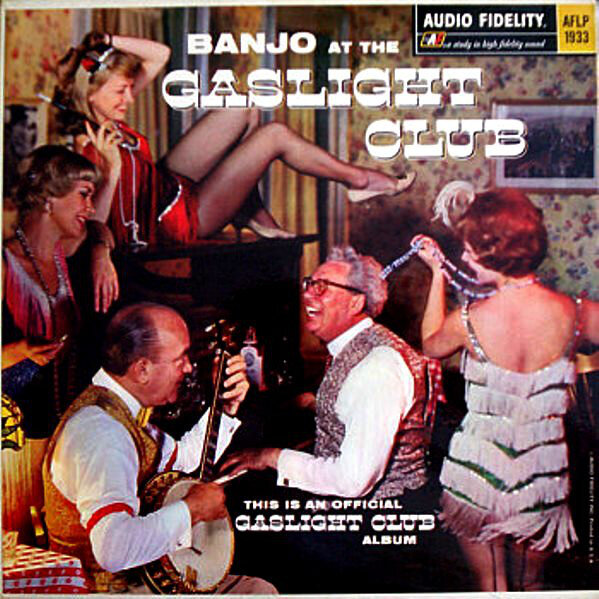
Favorite Don Ewell record? Whatever I’m listening to at the time. The “Ewell-touch” at the piano is always there, whether in solo performance or accompanying Mama Yancey, Olive Brown, Claire Austin, or in any of the trio/ensemble settings. Don`s playing evoked the past-masters, using his unerring taste and sense of form, generating his own creative mode of expression—“Don Ewell style”—which translates as “The Best of The Best.”
Hal Smith: The comments above are a real testament to Don Ewell’s incredible musicality. Nearly 40 years after his passing, “the Ewell touch” continues to inspire pianists and lovers of classic jazz piano everywhere—literally.
The Jazz Legacy of Don Ewell by the late John Collinson (Storyville Press, 1991) contains detailed biographical information, personal reminiscences (by John Dengler, Marty Grosz, Yoshio Toyama and others); a main discography, supplemental discography and transcriptions of his compositions by pianist Ray Smith. The book may be available from eBay or online booksellers such as Abebooks, Alibris, Powell’s Books and others.
If the reader is interested in hearing some of the recordings mentioned in the text, I am including a list of CDs that should be available for purchase via the internet. Also, for the online edition of TST, I have prepared a list of links to Don Ewell recordings from YouTube and Soundcloud.
Links to Don Ewell recordings mentioned in the article
Don Ewell and Baby Dodds (1946)
“Manhattan Stomp” – composed by Don Ewell
https://www.youtube.com/watch?v=2WHqQECbQts
Baby Dodds Trio (1946)
“Wolverine Blues”
https://www.youtube.com/watch?v=U4GZA34uTiQ
“Albert’s Blues”
https://www.youtube.com/watch?v=p6XiHlOuFro
Bunk Johnson Trio (1946)
“You’ve Got To See Mama Ev’ry Night”
https://www.youtube.com/watch?v=T602xsyReA8
“In The Gloaming”
https://www.youtube.com/watch?v=daeJklacoVo
“Poor Butterfly”
https://www.youtube.com/watch?v=1WAMjm393xs
Don Ewell Solo (1947)
“Parlor Social” – composed by Don Ewell
https://www.youtube.com/watch?v=a-WLjnw0svQ
Muggsy Spanier at Jazz, Ltd. (1949)
“A Good Man Is Hard To Find”
https://www.youtube.com/watch?v=i_NOnlvLtlo
Doc Evans at Jazz, Ltd. (1949)
“It’s A Long Way To Tipperary”
https://www.youtube.com/watch?v=uutlOfJt5Uc
Dewey Jackson (1952)
“Royal Garden Blues”
https://www.youtube.com/watch?v=C98hLkiljuc
“St. James Infirmary”
https://www.youtube.com/watch?v=hWikS9LPjzI
“When The Saints Go Marching In”
https://www.youtube.com/watch?v=oAOHut3JXn8
Don Ewell “King Oliver Creole Jazz Band Tunes” (1953)
“Snake Rag”
https://soundcloud.com/hal-smith-music/snake-rag
“Weather Bird”
https://soundcloud.com/hal-smith-music/track-7-weather-bird
Kid Ory’s Creole Jazz Band (1953 – 1954)
“Milneburg Joys”
https://www.youtube.com/watch?v=eR6n68nI5ho
“Maple Leaf Rag”
https://www.youtube.com/watch?v=Uavz6zT063I
“Wolverine Blues”
https://www.youtube.com/watch?v=GJS_yR3GkgA
“I Found A New Baby”
https://www.youtube.com/watch?v=tl8metYCkmo
Claire Austin with Kid Ory (1954)
“The World’s Jazz Crazy”
https://www.youtube.com/watch?v=WV6BTTreSE0
“Mecca Flat Blues”
https://www.youtube.com/watch?v=eRU6V5JsaEs
“Nobody Knows You When You’re Down And Out”
https://www.youtube.com/watch?v=h-cfGpuEdvM
Turk Murphy’s Jazz Band (1956)
“Mandy, Make Up Your Mind”
https://www.youtube.com/watch?v=izSID8kexr4
“Of All The Wrongs You’ve Done To Me”
https://www.youtube.com/watch?v=bOM3API2O8c
“New Orleans Stomp”
https://www.youtube.com/watch?v=jzx7r8ArM40
Don Ewell Trio (1956)
“South Side Strut” – composed by Don Ewell
https://www.youtube.com/watch?v=Bs4hCL7RHC4
“Monday Date”
https://www.youtube.com/watch?v=3OOgJLkP_Wc
“I Can’t Believe That You’re In Love With Me” (solo)
https://www.youtube.com/watch?v=qRzzHwohKpg
Don Ewell KPFA “Solo Recital” (1957)
https://www.youtube.com/watch?v=fZo_3CNnAmc
Album: Barbara Dane “Trouble In Mind” (1957)
https://www.youtube.com/watch?v=7eZQ5Gd2pGY
Don Ewell Quartet (1957)
“What’s The Use?”
https://www.youtube.com/watch?v=ob-clivH_V0
Jack Teagarden (1958)
“Walleritis” – composed by Don Ewell
https://www.youtube.com/watch?v=-vhj68M3fvY
Jack Teagarden Kinescope filmed in Japan (1958)
https://www.youtube.com/watch?v=SxDQ9Dcb5H4
Album: Jack Teagarden “At The Roundtable” (1959)
https://www.youtube.com/watch?v=Oeb1MMKCKgw
Don Ewell Quartet “Yellow Dog Blues” (1959)
“Yellow Dog Blues”
https://www.youtube.com/watch?v=c41twy-p4bY
“Michigan Water Blues”
https://www.youtube.com/watch?v=_w30SxSHerY
Album: Jack Teagarden “Jazz Maverick” (1960)
https://www.youtube.com/watch?v=M6RZAqdRWGE
Jazzology Poll Winners (1965)
“Sheik Of Araby”
https://www.youtube.com/watch?v=ReSSfMxkJFc
“Sentimental Journey”
https://www.youtube.com/watch?v=GJE50dDxVuk
“Ciribiribin”
https://www.youtube.com/watch?v=Olj2W3Wlblw
George Lewis/Don Ewell (1966)
“All The Girls Go Crazy”
https://www.youtube.com/watch?v=tRJ56FsgXls
“By The Light Of The Silvery Moon”
https://www.youtube.com/watch?v=PyCpRCyqiNc
“Toot, Toot, Tootsie”
https://www.youtube.com/watch?v=ZM6EAouV0-o
Don Ewell and Willie “The Lion” Smith “Grand Piano” (1966)
“I Would Do Anything For You”
https://www.youtube.com/watch?v=XebZYw2V_uU
“Can’t We Be Friends?”
https://www.youtube.com/watch?v=gwDjPfHOaOo
“Sweet Georgia Brown”
https://www.youtube.com/watch?v=UYIZbuEM9aM
Don Ewell/Barbara Dane Denver Concert (1966)
“Good Morning, Blues”
https://www.youtube.com/watch?v=7eZQ5Gd2pGY
“See See Rider”
https://www.youtube.com/watch?v=CUyuHx4m_Ho
“Kansas City Stomps”
https://www.youtube.com/watch?v=06Bzj7q8NtA
Earl Hines Medley
https://www.youtube.com/watch?v=LeXCCFt4-Bk
Don Ewell with Jimmy Archey (1967)
“Shim-Me-Sha-Wabble”
https://www.youtube.com/watch?v=xtMVSnXy3uo
“The Pearls”
https://www.youtube.com/watch?v=lqm_YE6a6uQ
“Four or Five Times”
https://www.youtube.com/watch?v=Y0nHSmElgwc
Don Ewell with Eddie Condon “Jazz As It Should Be Played” (1968)
“At The Jazz Band Ball”
https://www.youtube.com/watch?v=6Tud1pXe-0Y
“Squeeze Me”
https://www.youtube.com/watch?v=spQgY3VICBQ
“That’s A Plenty”
https://www.youtube.com/watch?v=XqvIX8YHzvw
Don Ewell “Jazz On A Sunday Afternoon” (1969)
“Love Will Last” – composed by Don Ewell
https://www.youtube.com/watch?v=i1smV8nbe5s
“Oh, Baby”
https://www.youtube.com/watch?v=I–nzhoC2MI
“Davenport Blues”
https://www.youtube.com/watch?v=CxnZJ_ADN1Y
Don Ewell “A Jazz Portrait Of The Artist” (1969)
“Migrant Worker Blues” – composed by Don Ewell
https://www.youtube.com/watch?v=3-bfAYchJXQ
“I’m Gonna Stomp Mr. Henry Lee”
https://www.youtube.com/watch?v=sSaDuHj44fQ
“Delmar Drag” – composed by Don Ewell
https://www.youtube.com/watch?v=mjxF7Xm-k7Q
Kid Ory rehearsal for New Orleans Jazz & Heritage Festival (1971)
“Milneburg Joys”
https://www.fellers.se/Kid/1971_New_Orleans
“Aunt Hagar’s Blues”
https://www.fellers.se/Kid/1971_New_Orleans
“That’s A Plenty”
https://www.fellers.se/Kid/1971_New_Orleans
Olive Brown (1972)
“Goody Goody”
https://www.youtube.com/watch?v=PyBMwVoDDWY
“Someday You’ll Be Sorry”
https://www.youtube.com/watch?v=PjhgBLoOHt8
“Every Day I Have The Blues”
https://www.youtube.com/watch?v=cwKb_6jnuQw
Don Ewell “Take It In Stride” (1973)
“Take It In Stride” – composed by Don Ewell
https://www.youtube.com/watch?v=I5KA1cm5Ar0
“A Hundred Years From Today”
https://www.youtube.com/watch?v=4pdTujxb8ZI
“Get Happy”
https://www.youtube.com/watch?v=G1eJ2vjHqQQ
Don Ewell and Yoshio Toyama (1975)
“Home”
https://www.youtube.com/watch?v=IFxXoASWd-o
“King Porter Stomp”
https://www.youtube.com/watch?v=mEdku5A6JfQ
“Body and Soul”
https://www.youtube.com/watch?v=urLMGk5bfpU
Don Ewell and Dick Wellstood (1979) – includes three solos by Dick Wellstood
https://www.youtube.com/watch?v=TBKutrBDs_8
Hal Smith is an Arkansas-based drummer and writer. He leads the El Dorado Jazz Band and the
Mortonia Seven and works with a variety of jazz and swing bands. Visit him online at
halsmithmusic.com























